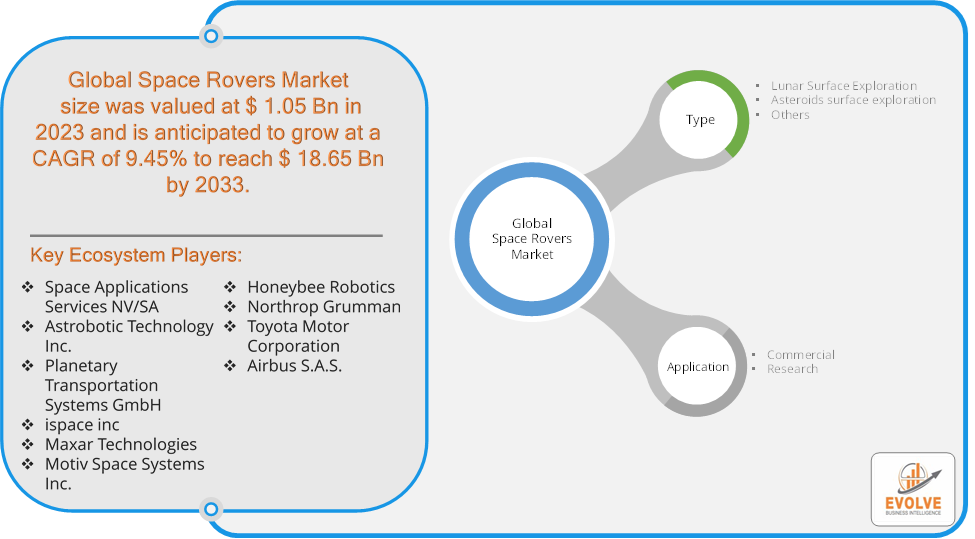Blog
Space Rovers Market Estimated to Record 9.45% CAGR During Forecast Period

Evolve Business Intelligence has published a research report on the Global Space Rovers Market, 2023–2033. The global Space Rovers Market is projected to exhibit a CAGR of around 9.45% during the forecast period of 2023 to 2033.
Evolve Business Intelligence has recognized the following companies as the key players in the global Space Rovers Market: Space Applications Services NV/SA, Astrobotic Technology Inc., Planetary Transportation Systems GmbH, ispace inc, Maxar Technologies, Motiv Space Systems Inc., Honeybee Robotics, Northrop Grumman, Toyota Motor Corporation and Airbus S.A.S.
 More Information: https://evolvebi.com/report/space-rovers-market-analysis/
More Information: https://evolvebi.com/report/space-rovers-market-analysis/
Market Highlights
The Global Space Rovers Market is projected to be valued at USD 18.65 Billion by 2033, recording a CAGR of around 9.45% during the forecast period. The Space Rovers Market refers to the global industry involved in the design, development, production, and deployment of space rovers. Space rovers are robotic vehicles designed to explore the surface of planets, moons, and other celestial bodies. These rovers are equipped with various scientific instruments to conduct experiments, collect data, and provide valuable insights into the geology, atmosphere, and potential for life in these environments.
The Space Rovers Market is an essential part of the broader space exploration industry, contributing to our understanding of the universe and paving the way for future human and robotic missions beyond Earth.
The COVID-19 pandemic had a significant impact on the Space Rovers Market. Lockdowns and restrictions led to the temporary closure of manufacturing facilities, causing delays in the production of space rover components. Transportation restrictions and reduced availability of shipping options impacted the timely delivery of parts and equipment. Transitioning to remote work environments posed challenges for collaboration and hands-on engineering tasks. While some tasks could be performed remotely, others, such as assembly and testing, required physical presence. The pandemic highlighted the need for increased automation and remote operation capabilities in space rovers, driving innovation in autonomous systems and AI. The pandemic highlighted the importance of supply chain resilience. This led to efforts to localize the production of critical components for space rovers, boosting domestic industries. The pandemic increased public awareness of space exploration as a source of inspiration and hope. This growing interest could translate into increased government and private investment in the future.
Segmental Analysis
The global Space Rovers Market has been segmented based on Type and Application.
Based on Type, the Space Rovers Market is segmented into Lunar Surface Exploration, Asteroids surface exploration and Others. The Lunar Surface Exploration segment is anticipated to dominate the market.
Based on Application, the global Space Rovers Market has been divided into Commercial and Research. The Research segment is anticipated to dominate the market.
More Information: https://evolvebi.com/report/space-rovers-market-analysis/
Regional Analysis
The Space Rovers Market is divided into five regions: North America, Europe, Asia-Pacific, South America, and the Middle East, & Africa. North America is dominated by the United States, primarily driven by NASA’s significant investments in space exploration. NASA continues to be a global leader in space exploration, with ongoing and planned missions involving advanced rovers, such as the Mars 2020 Perseverance rover. Companies like SpaceX, Lockheed Martin, and Blue Origin play a significant role in advancing rover technology and space exploration initiatives and strong government funding and a robust ecosystem of research institutions and tech companies drive innovation in the space rovers market. European Space Agency (ESA) plays a crucial role in driving the market. ESA’s involvement in missions like ExoMars highlights Europe’s commitment to space exploration and rover development and European countries collaborate with other space agencies and private companies to develop and deploy advanced rovers. In Asia-Pacific region, the China National Space Administration (CNSA) has successfully deployed rovers like Yutu-2 on the Moon and the Zhurong rover on Mars, showcasing significant advancements and the Indian Space Research Organisation (ISRO) has demonstrated its capabilities with missions like Chandrayaan and plans for future rover missions. India’s focus on cost-effective space exploration solutions contributes to the market by offering competitive alternatives. The Middle East and Africa region, the UAE’s growing interest in space exploration is exemplified by missions like the Hope Mars Mission and plans for future lunar exploration and significant investments in space technology and international collaborations are positioning the UAE as an emerging player in the market. In Latin America region, Brazil’s space program is gradually developing, with potential future involvement in rover missions and space exploration initiatives and collaboration among Latin American countries and with international space agencies can enhance regional contributions to the space rovers market.


